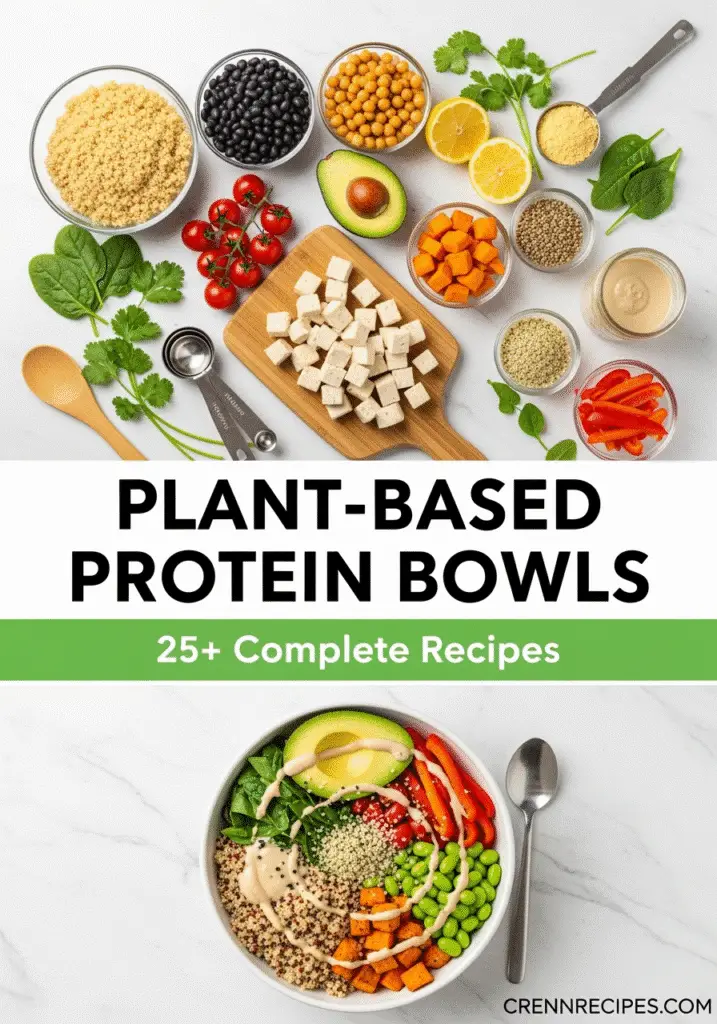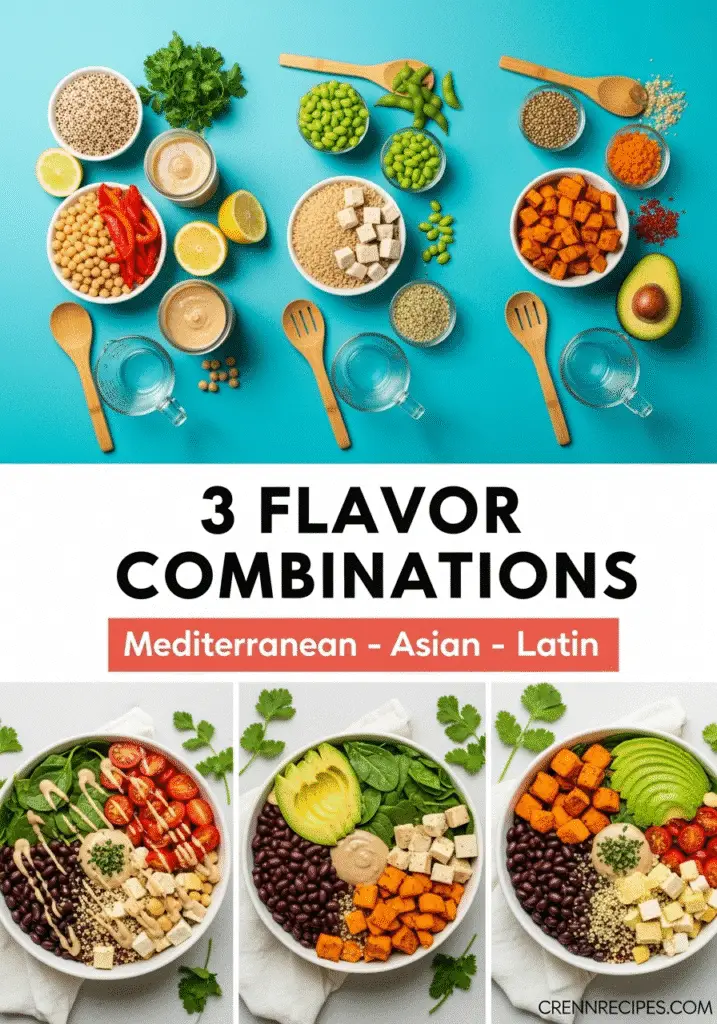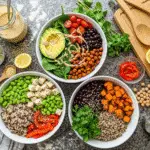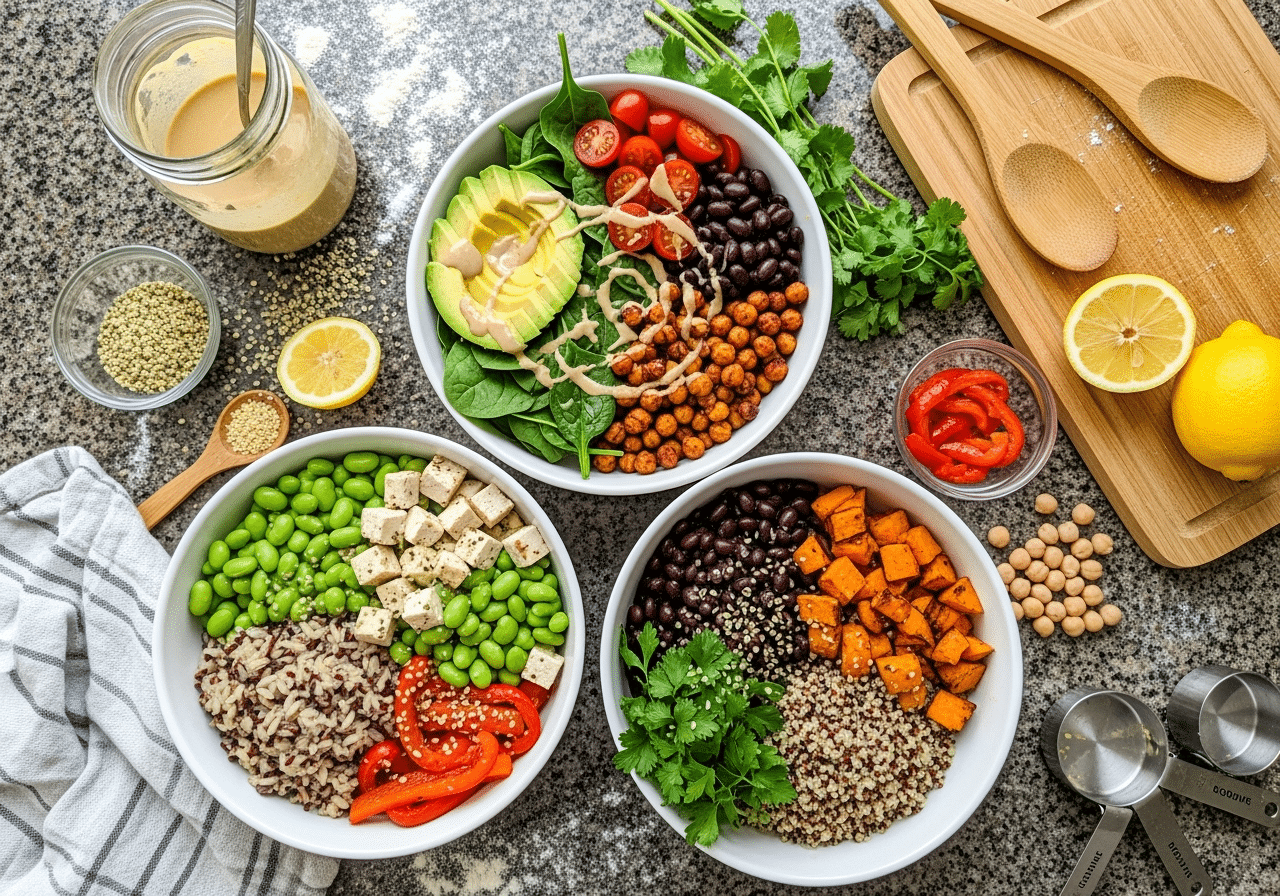Plant-based protein bowls have changed how we eat. They mix flavor, nutrition, and ease. These bowls are a tasty choice instead of meat.
These bowls are all about variety. They use vibrant ingredients for great taste and health. You can find everything from quinoa and black beans to veggie-packed bowls. They’re a fun way to eat well.
Exploring plant-based nutrition showed me these bowls are more than a trend. They’re good for you and the planet. By using whole grains, legumes, and veggies, they turn simple foods into amazing meals.
Key Takeaways
- Plant-based protein bowls offer complete nutritional profiles
- These meals are highly customizable and adaptable
- Vegan protein bowls support both personal and environmental health
- Ingredients can be prepped quickly for convenient meals
- Diverse flavor combinations prevent mealtime boredom

What are Plant-Based Protein Bowls?
Plant-based protein bowls have changed the way we eat, making healthy meals tasty and full of nutrients. These dishes mix different ingredients into one meal. They’re great for those who love preparing plant-based meals.
Protein bowl recipes are more than just food. They’re a mix of healthy parts that make a complete meal. Choosing to eat these bowls is a way to care for yourself and the planet.
Definition and Core Elements
A plant-based protein bowl has several important parts. Together, they make a meal that’s both balanced and tasty:
- Base grains: Quinoa, brown rice, or farro give you complex carbs
- Plant proteins: Tofu, tempeh, beans, or legumes add a lot of protein
- Fresh vegetables: Colorful veggies add vitamins and minerals
- Leafy greens: Spinach, kale, or arugula increase nutritional value
- Toppings: Seeds, nuts, and dressings add flavor
Popular Ingredients
When making protein bowl recipes, you can use many ingredients. Favorites include roasted chickpeas, marinated tofu, edamame, roasted sweet potatoes, and sauces like tahini or chimichurri.
Learning about plant-based protein bowls can make meal prep fun. It’s a way to feed your body and satisfy your taste buds.
Benefits of Plant-Based Protein Bowls
Vegetarian power bowls are a nutritional powerhouse. They offer great health benefits and help the environment. These meals are not only tasty but also support your health and the planet.
Nutritional Advantages
Plant-based protein bowls are packed with nutrients. They have:
- High fiber content for better digestion
- Essential vitamins and minerals
- Low calories for weight control
- Complete proteins from plants
Adding vegetarian power bowls to your diet is a smart choice. They provide balanced nutrition and are a great alternative to animal products.
Environmental Impact
Plant-based meals are good for more than just your health. They also benefit the environment:
- They produce less carbon emissions than meat
- Use less water in production
- Need less land for farming
- Protect ecosystems
Every vegetarian power bowl you eat helps the planet. By choosing plant-based options, you’re making a positive impact on the environment.
Types of Plant-Based Protein Sources
Creating nourishing protein bowls means knowing about plant-based proteins. We’ll look at the main sources that make your dishes protein-rich.
Legumes: Protein Powerhouses
Legumes are full of protein and nutrients. They’re key to many tasty protein bowls.
- Black beans: 15g protein per cup
- Lentils: 18g protein per cup
- Chickpeas: 14g protein per cup
Nuts and Seeds: Nutrient-Dense Additions
Nuts and seeds add protein and texture to bowls. They’re also rich in healthy fats and vitamins.
| Nut/Seed | Protein (per 1/4 cup) | Additional Benefits |
|---|---|---|
| Almonds | 7g | Vitamin E, Magnesium |
| Chia Seeds | 5g | Omega-3 Fatty Acids |
| Hemp Hearts | 10g | Complete Protein |
Whole Grains: Complex Protein Sources
Whole grains offer protein and lasting energy for plant-based dishes. They’re top choices for protein bowls.
- Quinoa: 8g protein per cup
- Amaranth: 9g protein per cup
- Teff: 10g protein per cup
Pro tip: Mixing different plant-based proteins gives you all the amino acids you need in your meals.
How to Build a Balanced Protein Bowl
Making Plant-Based Protein Bowls is an art that blends nutrition and taste. These bowls are great for a full meal with balanced ingredients. Let me show you how to make the best plant-based protein bowl that tastes good and is healthy.
Selecting the Perfect Base
Your protein bowl’s base is key for a nutritious meal. Here are some top choices:
- Quinoa – a complete protein grain
- Brown rice – rich in fiber
- Mixed leafy greens
- Cauliflower rice
- Sweet potato cubes
Protein Power Selection
Protein is the main attraction in healthy protein bowls. Here are some plant-based protein options:
| Protein Source | Protein Content | Additional Benefits |
|---|---|---|
| Tofu | 8g per 1/2 cup | Low calorie, versatile |
| Chickpeas | 7g per 1/2 cup | High in fiber |
| Lentils | 9g per 1/2 cup | Iron-rich |
Toppings and Dressings
Make your Plant-Based Protein Bowls even better with tasty toppings and dressings. Pro tip: Add crunch with nuts, seeds, or roasted chickpeas. Try tahini, lemon-herb, or spicy almond sauce for extra flavor.
- Avocado slices
- Roasted vegetables
- Nutritional yeast
- Fresh herbs
By mixing and matching these ingredients, you’ll get a meal that’s both nutritious and satisfying. It will keep you energized and well-nourished.
Creative Flavor Combinations
Exploring plant-based meals opens up a world of flavors from around the globe. Protein bowls are a great place to mix these flavors. Each culture adds its own twist, making simple ingredients into amazing dishes.
Adding global flavors to your protein bowl recipes can make them stand out. Let’s look at three cuisines that can inspire your next dish.
Mediterranean Influence
Mediterranean bowls are full of life with their fresh ingredients and bold tastes. You’ll find:
- Hummus as a creamy base
- Kalamata olives
- Roasted red peppers
- Fresh herbs like parsley and mint
- Israeli couscous or quinoa
Asian-Inspired Bowls
Asian bowls are known for their deep, savory flavors. They often include:
- Edamame
- Miso dressing
- Pickled vegetables
- Sesame seeds
- Crispy tofu
Latin American Flavors
Latin American bowls are spicy and full of life. They feature:
- Black beans
- Fresh salsa
- Roasted corn
- Cilantro
- Lime-infused dressing
By using flavors from around the world, you can make protein bowls that are both healthy and exciting. Each culture brings its own way of cooking, making your meals always interesting.

Meal Prep Tips for Plant-Based Protein Bowls
Learning to prep plant-based meals can make your vegan protein bowls a breeze. It saves time, reduces stress, and keeps healthy meals ready to go.
Good plant-based meal prep needs planning and smart use of ingredients. My method boosts efficiency without losing flavor or freshness in your vegan bowls.
Preparing Ingredients in Advance
Great vegan protein bowls start with smart prep. Here are my best tips:
- Cook grains like quinoa and brown rice in big batches
- Roast veggies for the week during weekend prep
- Prepare proteins like tofu, tempeh, and legumes ahead of time
- Wash and chop fresh herbs and greens
Smart Storage Guidelines
Right storage keeps your prep ingredients fresh:
- Store cooked grains in airtight containers for up to 5 days
- Keep roasted veggies separate from grains to avoid sogginess
- Use glass containers for better ingredient freshness
- Refrigerate prepared parts at 40°F or below
With these prep tips, you’ll make tasty and healthy vegan protein bowls easily. The secret is in the prep, organization, and creativity.
Spotlight on Popular Recipes
Exploring tasty protein bowl recipes can change how you plan meals and eat. These recipes show how plant-based food can be both versatile and flavorful. Let’s dive into three amazing recipes that will spark your cooking creativity.
Mediterranean-Inspired Chickpea and Quinoa Bowl
This vibrant bowl recipe is packed with nutrients for a fulfilling meal. It includes:
- Roasted chickpeas seasoned with paprika and cumin
- Fluffy quinoa as a protein-rich base
- Roasted Mediterranean vegetables
- Zesty lemon-herb dressing
Asian-Inspired Tofu Stir-Fry Bowl
This bowl is full of flavor and protein, making it a hit in your kitchen. It’s made with:
- Crispy pan-seared tofu cubes
- Brown rice
- Colorful mixed vegetables
- Ginger-soy sauce
Middle Eastern Lentil Tahini Bowl
This bowl celebrates bold, rich flavors from the Middle East. It’s filled with:
- Spiced warm lentils
- Creamy tahini dressing
- Fresh herbs like parsley and mint
- Roasted garlic and spices
Each recipe offers a unique taste experience and balanced nutrition. They show how plant-based foods can make exciting, nutritious meals that keep you full and energized.
Common Mistakes to Avoid
Making tasty healthy protein-packed bowls is more than just mixing ingredients. Many people make big mistakes that hurt the meal’s nutrition and taste. Knowing these common errors can help you make better vegetarian power bowls.
Overloading on Carbohydrates
One big mistake is having too many carbs in your bowl. This can make your meal less protein-rich and less nutritious. Plant-based cooking experts say it’s key to balance your food groups well.
- Limit grains to 1/4 of your bowl
- Prioritize protein-rich ingredients
- Include plenty of vegetables
Neglecting Flavor Combinations
Healthy protein-packed bowls are not just about being healthy—they’re about being delicious. Not thinking about flavors can make your meals taste dull and unsatisfying.
| Flavor Category | Recommended Pairings |
|---|---|
| Earthy | Roasted chickpeas, tahini, cumin |
| Bright | Citrus dressings, fresh herbs |
| Umami | Miso, nutritional yeast, soy sauce |
By avoiding these mistakes, you can turn your vegetarian power bowls into something amazing. Try new ingredients, keep your macronutrients in balance, and don’t be shy about experimenting with flavors.
How to Customize Your Protein Bowl
Plant-Based Protein Bowls are super flexible for tasty and healthy meals. They can be made to fit your diet and taste. This makes them great for anyone looking for a good meal.
Addressing Dietary Restrictions
It’s easy to make your own plant-based protein bowls. Just know what you need. Here are some tips:
- Gluten-Free Options: Use quinoa, rice, or millet instead of wheat
- Low-FODMAP Alternatives: Pick zucchini, carrots, or veggies you can eat
- Nut-Free Protein Sources: Try sunflower or pumpkin seeds
- Soy-Free Protein: Add lentils, chickpeas, or hemp seeds
Personalizing Your Flavor Profile
High-protein plant-based dishes are all about trying new things. Here’s how to find your favorite bowl:
- Begin with a grain or veggie you like
- Choose proteins that taste good to you
- Add different toppings for texture and taste
- Try new seasonings from around the world
Your plant-based protein bowl should be just right for you. Feel free to get creative and make something amazing!
Where to Find Plant-Based Protein Bowls
Finding vegan protein bowls is now easier than ever. Many places across the United States offer them. Local cafes and restaurants have started to add delicious plant-based meals to their menus.
Places like Portland, San Francisco, and New York are leading the way. They have trendy restaurants and health-focused eateries with vegan protein bowls. Brands like Sweetgreen and Tender Greens have also added plant-based options to their menus.
Discovering Local Dining Options
Look for local cafes and restaurants that focus on plant-based food. Yelp and Google Maps can help you find top-rated vegan protein bowls. Instagram is also great for finding local spots and getting ideas.
Online Recipe Resources
For those who love to cook at home, there are many recipe blogs and cookbooks. Sites like Minimalist Baker, Oh She Glows, and Pick Up Limes have lots of vegan protein bowl recipes. A plant-based cookbook can also be a great source of inspiration for making tasty meals at home.
FAQ
What exactly are plant-based protein bowls?
Plant-based protein bowls are meals with a grain or leafy base. They include legumes, tofu, or quinoa, and veggies. Topped with a tasty dressing, they offer a balanced meal without animal products.
How much protein do plant-based protein bowls typically contain?
These bowls usually have 15-25 grams of protein. This comes from ingredients like quinoa, lentils, and tofu. Mixing different proteins gives you all the amino acids you need.
Are plant-based protein bowls good for weight management?
Yes, they’re great for managing weight. They’re full of fiber and nutrients. This helps control hunger and supports metabolism while keeping calories in check.
Can I prepare plant-based protein bowls in advance?
Absolutely! You can cook grains, veggies, and proteins ahead of time. Store them in the fridge for 3-5 days. Just keep dressings and fresh ingredients separate until you’re ready to eat.
Are plant-based protein bowls suitable for people with dietary restrictions?
These bowls are very flexible. You can make them gluten-free, nut-free, soy-free, or low-FODMAP. Choose the right ingredients for your needs, and you can enjoy a bowl that’s just right for you.
How can I ensure I’m getting complete proteins in a plant-based bowl?
Mix different plant proteins like quinoa with beans or nuts. Amaranth, buckwheat, and hemp seeds are also complete proteins. They help make your bowl more nutritious.
What are some budget-friendly plant-based protein sources?
Beans, lentils, chickpeas, rice, oats, and frozen veggies are affordable. Buying in bulk and using dried legumes can save money. They’re also very nutritious.
How do plant-based protein bowls contribute to environmental sustainability?
These bowls are better for the planet than meat-based meals. They use less water, produce fewer greenhouse gases, and need less land. Choosing them is a green choice.
Can plant-based protein bowls help with muscle building?
Yes, they can support muscle building if they have enough protein and nutrients. Use tofu, tempeh, and seitan. Add complex carbs and healthy fats for muscle recovery and growth.
What are some quick dressing ideas for plant-based protein bowls?
Try tahini-lemon sauce, nutritional yeast vinaigrette, or avocado-cilantro blend. Spicy peanut sauce and balsamic reduction are also great. They add flavor in no time.

Plant-Based Protein Bowls: 25+ Nutritious Recipes That Boost Energy
- Total Time: 35 minutes
- Yield: 2 servings 1x
Description
A vibrant Mediterranean-inspired protein bowl with roasted chickpeas, fluffy quinoa, and zesty lemon-herb dressing
Ingredients
1 cup cooked quinoa
1 cup roasted chickpeas
1/2 cup roasted red peppers
1/4 cup kalamata olives
2 tbsp tahini
1 tbsp lemon juice
2 cups mixed greens
Instructions
1. Cook quinoa according to package directions
2. Roast chickpeas with olive oil and spices
3. Prepare vegetables
4. Whisk tahini dressing
5. Assemble bowl with quinoa base
6. Top with chickpeas and vegetables
7. Drizzle with dressing
Notes
Store components separately for meal prep
Dressing keeps for 5 days refrigerated
- Prep Time: 15 minutes
- Cook Time: 20 minutes
- Category: Main Course
- Method: Assembly
- Cuisine: Mediterranean
Nutrition
- Serving Size: 1 bowl
- Calories: 425
- Sugar: undefined
- Sodium: undefined
- Fat: undefined
- Saturated Fat: undefined
- Unsaturated Fat: undefined
- Trans Fat: undefined
- Carbohydrates: undefined
- Fiber: undefined
- Protein: 18g
- Cholesterol: undefined

